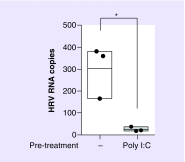Antiviral therapeutic approaches for human rhinovirus infections
- PMID: 30245735
- PMCID: PMC6136076
- DOI: 10.2217/fvl-2018-0016
Antiviral therapeutic approaches for human rhinovirus infections
Abstract
Human rhinoviruses are the primary etiological agent of the common cold. This infection can be mild and self-limiting in immunocompetent hosts, but can be associated with bronchiolitis in infants, pneumonia in the immunosuppressed and exacerbations of pre-existing pulmonary conditions such as asthma or chronic obstructive pulmonary disease. Many of these conditions can place significant economic costs upon healthcare infrastructure. There is currently no licensed vaccine for rhinovirus, as the large variety of rhinovirus serotypes has posed significant challenges for research. In this review, we discuss current knowledge around antiviral drugs and small molecule inhibitors of rhinovirus infection, as well as antiviral host defense peptides as exciting prospects to approach the development of novel therapeutics which target human rhinovirus.
Keywords: antiviral drugs; cathelicidin; interferon; peptide; rhinovirus; vitamin D.
Conflict of interest statement
Financial & competing interests disclosure This work was supported by a funding award from the Chief Scientist Office (ETM/389) awarded to PG Barlow and C Stevens. FH Sousa is supported by a 50th Anniversary PhD studentship from Edinburgh Napier University. The authors have no other relevant affiliations or financial involvement with any organization or entity with a financial interest in or financial conflict with the subject matter or materials discussed in the manuscript apart from those disclosed. No writing assistance was utilized in the production of this manuscript.
Figures


References
-
- Gern JE, Galagan DM, Jarjour NN, Dick EC, Busse WW. Detection of rhinovirus RNA in lower airway cells during experimentally induced infection. Am. J. Respir. Crit. Care Med. 1997;155(3):1159–1161. - PubMed
-
- Arruda E, Boyle TR, Winther B, Pevear DC, Gwaltney JM, Jr, Hayden FG. Localization of human rhinovirus replication in the upper respiratory tract by in situ hybridization. J. Infect. Dis. 1995;171(5):1329–1333. - PubMed
-
- Winther B, Gwaltney JM, Hendley JO. Respiratory virus infection of monolayer cultures of human nasal epithelial cells. Am. Rev. Respir. Dis. 1990;141(4 Pt 1):839–845. - PubMed
Publication types
LinkOut - more resources
Full Text Sources
Other Literature Sources
